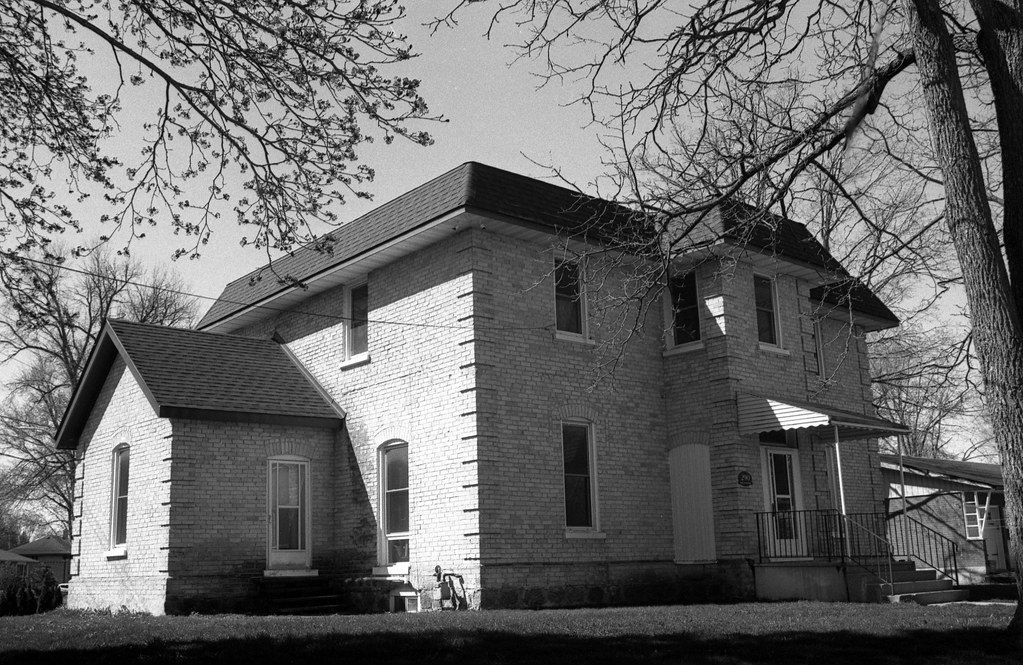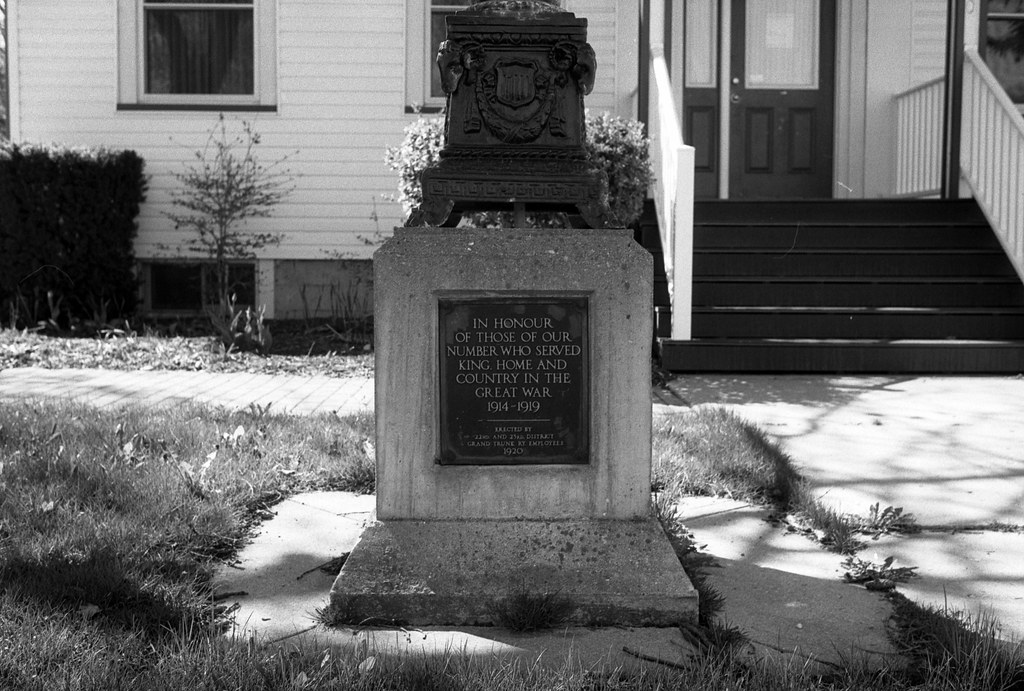It felt good to get up and out of my own little part of the province, and a solid drive (only an hour and a half) put me well outside the paved sections of the Greater Toronto Area to the small community of Palmerston. A community that owes its founding to the railroad, a rarity here in Ontario where most communities were founded along a river, canal, major road, or post-war colonization. While you can walk end-to-end in a short time, there is a lot more to Palmerston than the railroad alone; there is also some medical history to the community that helped defeat a once major illness.

Nikon FM – AI-S Nikkor 35mm 1:2.8 – Fomapan 100 @ ASA-100 – Rollei Supergrain (1+15) 7:30 @ 20C
The earliest European settler in what would become Palmerston dates to 1854, Thomas McDowell. While there would be a small farming settlement with a handful of families, the real growth didn’t occur until the 1870s. The main catalyst was the railroad, a rarity in Ontario as most development and settlement took place along rivers, canals, or provincial roads. The opening of the Wellington, Grey, and Bruce Railroad saw construction drive through the small community. McDowell and Thompson, two prominent landowners, began dividing out their land, surveying a townsite and lots with the right-of-way forming the core of the planned community. One of the largest purchasers was Wellington, Grey, and Bruce, who built a single-story station. The branch line arrived in 1874, and a post office and customs house were built at that point, and the name Palmerston was chosen. Named for Sir Henry John Temple, the Third Viscount of Palmerston. Lord Palmerston being a major figure in the British government from the 1830s to his death in 1865. By the time the railroad arrived, the community’s population had increased tenfold from the previous year, allowing incorporation as a town. Despite the town’s location, it quickly became a major hub for railroad activity, Great Western and later Grand Trunk would take over operations in 1876 and 1882, respectively. Under Grand Trunk, Palmerston was a junction of sixty-five subdivisions in the vast Grand Trunk network. Because of this and the rural setting, Dr Alexander Stewart established Ontario’s first Vaccine Farm in 1885. And when I say farm, I mean an actual farm. Dr Stewart took over a small farm with a brick house and a cow barn to produce and obtain the smallpox vaccine. The railroad would be able to move the vaccine anywhere in Ontario in a rapid manner. After Dr Stewart died in 1911, most of the Ontario vaccines were coming from American farms; the work continued in Palmerston until 1916 when the vaccine production moved to Toronto and the University of Toronto Antitoxin Laboratory. Canadian National would continue to operate the yards after taking over Grand Trunk operations in 1923. Unlike smaller lines, steam continued to dominate passenger travel well into the middle of the 20th Century. However, by 1960 diesel had taken over, CN demolished several buildings, including the roundhouse and turntable. Passenger service ceased in the 1970s, and through the 1980s and 1990s, many of the subdivisions were closed, with the final train leaving in 1996 never to return. With the help of CN, the town purchased the former yard, restoring the station to how it would have appeared in the early 20th Century under Grand Trunk, restored the pedestrian bridge, and converted the area into a park and museum. In 1999, Palmerston and Harriston, along with the surrounding areas, were amalgamated into the town of Minto.

Nikon FM – AI-S Nikkor 35mm 1:2.8 – Fomapan 100 @ ASA-100 – Rollei Supergrain (1+15) 7:30 @ 20C
Nikon FM – AI-S Nikkor 35mm 1:2.8 – Fomapan 100 @ ASA-100 – Rollei Supergrain (1+15) 7:30 @ 20C
While I ended up with a great selection of photos this week, that also made it harder to choose which ones to include. Given the prominence of the Railroad in the town’s development, I had to choose the Palmerston Railway Museum as the featured image this week. The downtown presented a uniform skyline, no steeples or anything to make it interesting. And while I could have easily dominated the entire set with photos from CNR park (former railway right-of-way and yards), I had to add some variety. Still, it is also why I included the small memorial plaque raised by the former Grand Trunk Employees to the town’s war dead (World War One). The Vaccine Farm building provided a nice little historical building, while a boring building, being able to see where Ontario’s fight against smallpox was based warranted its inclusion. Another interesting part about Palmerston is how many buildings that are usually prominent in the downtown area found on side streets, the United Church and the Post Office are located nearer to the railway station, no surprise at the post office as it also included the custom’s house. And yes, the church remains an active congregation, and the post office is still a post office. I did have to include at least one main downtown building, and this small block now housing a thrift store is one of the oldest standing datings to 1872, and the final image a house I included because I liked the way the light and shadow fell.

Nikon FM – AI-S Nikkor 35mm 1:2.8 – Fomapan 100 @ ASA-100 – Rollei Supergrain (1+15) 7:30 @ 20C
Nikon FM – AI-S Nikkor 35mm 1:2.8 – Fomapan 100 @ ASA-100 – Rollei Supergrain (1+15) 7:30 @ 20C
After nine weeks of struggling (again) with Fomapan 200, I can finally welcome my favourite film from the Foma line for the next eighteen weeks, Fomapan 100. But it also gives me time to experiment a bit more with different developers, a little over/under exposure, and push/pull in development. But given I was on a tight timeline, I didn’t want to try anything fancy in the field. I ended up shooting the film at ASA-100, or box speed. For the lens, I went with the 35mm f/2.8, and for once, I actually did not feel I needed to bring any other lenses; the 35mm fit the feel of the area perfectly. The one thing I did wish I had remembered was a yellow filter to help knock back the skies a little. I went with Rollei Supergrain, another developer from Germany that I started experimenting with last year for the developer. The results were excellent, helping bring out the sharpness without overly increasing the visibility of the grain. I find it odd that the time was not listed on the Massive Dev Chart but is listed on the Supergrain bottle.

Nikon FM – AI-S Nikkor 35mm 1:2.8 – Fomapan 100 @ ASA-100 – Rollei Supergrain (1+15) 7:30 @ 20C
Nikon FM – AI-S Nikkor 35mm 1:2.8 – Fomapan 100 @ ASA-100 – Rollei Supergrain (1+15) 7:30 @ 20C
Next week we’re headed further west to a section of Ontario known for its Mennonite population and an awesome farmer’s market, St. Jacobs (but without the market because of crowds).